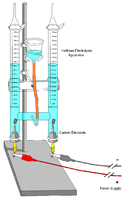
Photo from wikipedia
HPC is an ashless coal obtained via the thermal extraction of coal and is soluble in organic solvents. In this study, carbon powder was prepared from the HPC/pyridine solution via… Click to show full abstract
HPC is an ashless coal obtained via the thermal extraction of coal and is soluble in organic solvents. In this study, carbon powder was prepared from the HPC/pyridine solution via precipitation using water as a poor solvent and was subsequently carbonized via heat treatment at 900°C. The evaluation of the pore characteristics of the obtained carbon powder revealed that the carbon powders mainly contained micropores. The average pore diameter (Dave) of the micropores was 0.75 nm, suggesting that they are super-micropores or ultra-micropores. The applicability of the carbon powder was verified by examining the EDLC characteristics. The capacitance of the EDLC containing the aqueous solution of H2SO4 as the electrolyte was 170 F cm −3 (200–210 F g) at a current density of 50mA g, denoting a capacitance similar to that of the activated carbon powder (YP-50F). The capacitance was 140 F cm (170 F g) even when the current density increased from 50 to 5000mAg, indicating a high retention rate of approximately 80%. Subsequently, the capacitance became 210 F cm (260 F g) when the CO2 activation treatment was conducted for 60 or 90min. Therefore, a high yield of carbon powders with extremely fine pores can be easily obtained via precipitation using HPC as the raw material. © The Author(s) 2020. Published by ECSJ. This is an open access article distributed under the terms of the Creative Commons Attribution 4.0 License (CC BY, http://creativecommons.org/licenses/by/4.0/), which permits unrestricted reuse of the work in any medium provided the original work is properly cited. [DOI: 10.5796/electrochemistry.20-63011]. Uploading "PDF file created by publishers" to institutional repositories or public websites is not permitted by the copyright
Journal Title: Electrochemistry
Year Published: 2020
Link to full text (if available)
Share on Social Media: Sign Up to like & get
recommendations!